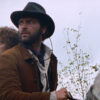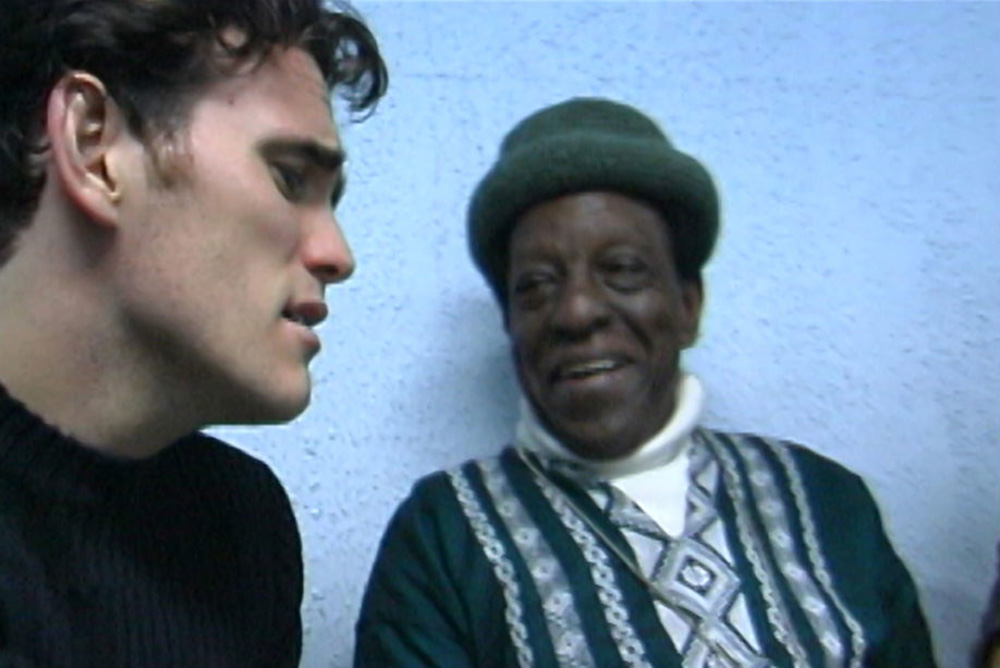It wouldn’t be all that long after Matt Dillon played a music impresario in Allison Anders’ lovely 1996 drama “Grace of My Heart” that he stumbled into becoming one in real life, compelled by his love of Afro-Cuban music to take a trip to Mexico City with his friend, musician Joey Altruda, in search of one of the movement’s foundational figures in Francisco Fellove. Known as “El Gran Fellove,” he wasn’t particularly difficult to locate when anyone in the streets with a guitar or the drums could lure him out for an impromptu jam session, still an electrifying and deeply engaged performer well into his seventies who had helped popularize improvised scat singing as an integral part of Cuban big band and jazz music. Nor did it take much coaxing to get him into the studio when Dillon and Altruda convened some sessions for what would be his first album in 20 years.
What would take some time, however, is bringing the music and the sensational story behind it to the masses, a process that has taken over 20 years and six production companies — Peaceable Assembly Productions, Viento del Norte Cine, Paloma Negra Films, RadicalMedia, NiKA Media and Insurgent Media — to pull off, with “El Gran Fellove” making its North American premiere this week at Telluride. Fitting for a musician that Dillon describes as having “a voice that made him seem eight feet tall,” the film hadn’t been conceived of as an epic, but increasingly took on those proportions after Dillon and Altruda left Mexico City with the recordings and a conversation starter with a number of other Afro-Cuban greats, who not only could pay tribute to Fellove, but saw his journey in similar terms as their own when the opportunity at a fulfilling life could only come in a country other than where they had been born.
Although Dillon doesn’t dare demystify the magic around the music in “El Gran Fellove,” he does pull the curtain back on the pipeline of artists who began migrating from Cuba under communist rule to the far more welcoming shores of Mexico where Fellove’s contemporary Jose Antonio Mendez, a leader in the Filin movement (a Latin music genre taking its name from the American word “feeling,” for its great emotionality), helped create a community for expatriates and Mariano Rivera Conde, an RCA exec, amplified their efforts. A vibrant music scene emerged, and while it would fade as musical tastes changed, the musicians themselves remained as active as ever, making “El Gran Fellove” full of energy when every present-day interview Dillon conducts in Havana, Mexico City and elsewhere feels less than a step away from breaking out into an impromptu performance. Sadly, Fellove passed away in 2013 before he could see his final album released, but with the stars finally aligned, his spirit is alive and well in “El Gran Fellove,” which is bound to bring a new generation’s attention to his music and shortly before it touches down in Colorado, Dillon spoke about having to already move mountains to get the film to the finish line and realizing at every turn that it was about something more than he had initially thought.
What was the impetus to pull this all together now?
I think it happened when it was meant to happen in a way. I never gave up on the project. I knew that the footage was really interesting. I was there for three weeks with Fellove, with Joey, and with Chocolate [Ormenteros, a trumpeter and friend to Fellove] and the [other] musicians, and I knew it was something great, but not having a background in documentaries, I wasn’t really sure what to do with it. Then at a certain point, I had to commit to saying, “Let’s go back into this” and when I went back into the project, as remarkable a showman as Fellove was, I didn’t want it to just be this piece about this one artist because I thought there’s a bigger story here.
The bigger story was Cuban artists immigrating to Mexico at that time — there was a huge film industry and the mambo was born there. That’s what I thought the film was about and Fellove was a part of that, but he was just a part of that. This music is so interesting to me — I love African music [generally], but particularly this remarkable group of young, disenfranchised people that were great artists — young, black and mulatto kids that were living in Havana and creating music based on the American jazz that they were hearing on the jukeboxes — were such an interesting group of people and Fellove was part of that group, so I was really interested in telling that story. These guys were called the Filin Kids — they heard the word “feeling,” but they didn’t know what it meant, and then somebody said, “Sentimiento, sentimiento,” and then they changed the way Cuban music was played. And Fellove was the guarachero, the Mambo guy, the guy who brought that flavor, that scat, that jazzy flavor, and yet was distinctly Cuban.
So when I got down there and I started to talk to everybody, I realized that his story was the whole story — everything that he went through, they all went through. So it was a profound moment for me. I went back [to Mexico City] to see him, and I was unable to and that’s where I really went into the business of getting to know who he was. The difficult part was I want to tell you the story of this incredible period of music, but it’s data, it’s information, and people cannot absorb information unless they feel an emotional connection, so [it was about] bridging of that gap is getting into this person so we can connect. In my experience, I discovered emotion is first and information second, so that’s why I like documentary films. I want to learn something, but I also want to feel something. I also want to experience the meaning of life in the film.
From the earliest footage you film of the Mexico City sessions, you can feel the creative energy in how you choose to shoot it. You likely refined it in the edit, but was rhythm of this always there for you?
That’s just something you have to feel it out as you go. The dramatic arc, if there is one, of this journey of Fellove [is that] when we got there, we could see that the magic was still there, but he was 77, with illness setting in — Parkinson’s — you could feel it, and yet when he walked in the room, we were all just mesmerized by this showman, this personality that just lit up the room, so you’re looking at a talent and brilliance that has been dormant — he hadn’t done anything for a while, and yet you can see it’s still all there, but he wasn’t going to be able to do it for very much longer. However, he brings all this other stuff with him and it’s really a wonderful time to look at the late period of an artist. Every artist’s dream is to have a late period, and that’s been said about a lot of painters, but in Fellove’s case, it was musical.
He was just a kind of a wandering poet, in his own way, and I loved him very much. He didn’t know who the hell I was. [laughs] People told him, “That guy’s a big fan of yours, man,” because at first he thought I was a guy working on the video crew, just getting in the way, but then he started to become really fascinating at this idea. He started to have these expectations that there will be this renewed interest in his life and everything he had done. It was very moving, because he was worthy of that. This was a talented man, but also like a great blues artist and when you think of the blues, the blues is a sadness. With Fellove, there was a sadness there. Underneath all that joy, there was a little sadness there, that he came from these difficult circumstances in life and was just underneath the surface, but that’s the soul.
I get the sense that while you had less direct access to him over time, you got to experience him through others, just in their behavior. There’s that wonderful scene in the film with Bobby Carcassés, where he’s tapping on the arms of the chair as he’s waiting to be interviewed. You just feel like the music’s in him. Even without the actual interviews, was just being around some of these musicians informative?
That was my experience. When I went back down to revisit the project after all these years, I never gave up on the footage [from Mexico City], but not having a background as a documentary guy, I didn’t know what to do with it and when I went down there and I started to interview people, all they to do is talk about Fellove and I realized that because I was thinking the story would take these other turns — [which] it does but always connected to this journey that this one individual took — his story connected with all the artists that were going down there. And I did a lot of interviews, not because I wanted to do a talking-head type documentary, but I happened to interview some of the most fascinating talking heads that you’ve ever talked to. I mean, Chocolate Ormenteros was an incredible character, and these stories that these people have to share, they needed to be.
When we contacted Bobby, who is a great, brilliant scat singer/trumpet player/drummer, he’s essentially a disciple of Fellove. He comes from this world of feeling and jazz and scatting, and he said, “I have to talk about Fellove, because of that special thing that he had and to recognize that.” So Bobby said many wonderful things, and so many of the people that I interviewed. Unfortunately, I was not able to use it all in the film, but they’re there for posterity and we knew the stories, the anecdotes and the things people said have historical significance.
There may not be any connection for you, but I’ve admired the fact that you’ve used the capital you’ve accrued in your career as an actor to direct projects that shine a light on parts of the world that elude the big screen, whether with this film or Cambodia with “City of Ghosts.” Has exploring other cultures been a conscious choice when you know how long these projects can take?
Curiosity has been one of my strongest assets, I would say, and I was fortunate at a very, very young age to be able to see the world and other cultures. Sometimes, like in the case with this, I love Cuban music, but the music I grew up with as a kid in New York and in the suburbs was Irish folk records that my father kept, which [now] is very foreign to me and yet very close to me in a way. I’m an American, but I love all kinds of music. I like punk rock, and funk, ska and reggae, and jazz, of course, so everything comes back to that. I have to say it was beautiful because Joey was a white American guy in California, who is jazzy and a great musician, and he connected with Fellove, a much older Afro-Cuban guy, but they had this connection with the music. None of the rest of it mattered and it’s a beautiful thing.
After living with this for 20 years on and off, what’s it like to start seeing it out in the world?
It’s really nice when you show it to an audience and their heart is open to it. You ask yourself questions all the time, will people understand? Will they be open to this musical message of Fellove? And it’s beautiful when they do get it. If there’s really one deep theme in this film for me, it’s about friendship —[between] Joey and myself, and the friendships Fellove had with many people, including myself and Joey, but it wasn’t about that. It was about a little bit of our relationship, but [really] his friendship with those other musicians that he came up with [such as] Jose Antonio Mendez. When he spoke about [Mendez], way back in 1999, this brilliant songwriter from the Cuba who’s the one who said, “I’m going to bring you to Mexico because there’s no discrimination in Mexico [due to] the color of your skin. You will be able to thrive, and welcomed with open arms into this industry,” that was important for me. It was the land of opportunity for him and so many others and [when] we got some nice reviews on the film [out of its premiere at San Sebastian], it touched me, because people recognized that. It’s a story of friendship.
“El Gran Fellove” will screen at the Telluride Film Fest on September 4th at 4 pm at the Sheridan Opera House.




